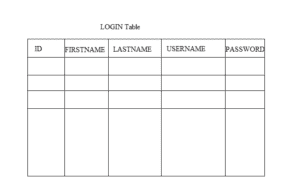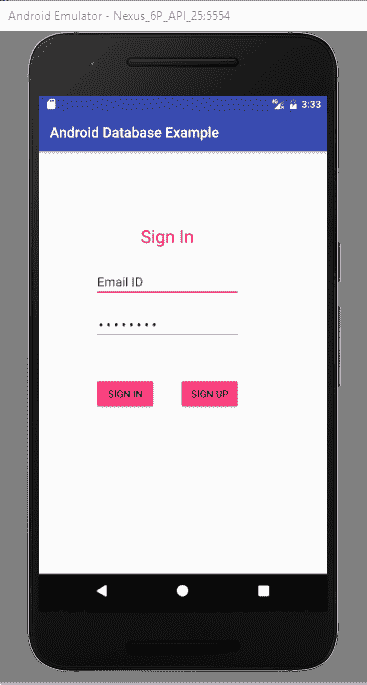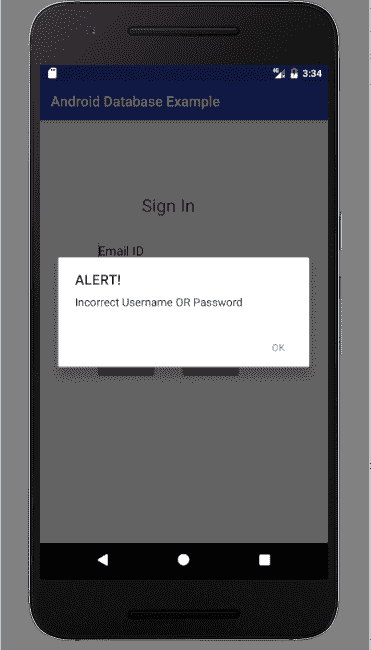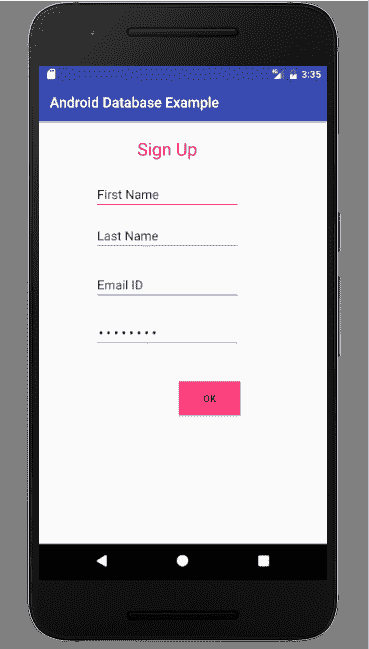# Android SQLite 数据库示例
> 原文: [https://javatutorial.net/android-sqlite-database-example](https://javatutorial.net/android-sqlite-database-example)
[上一教程(https://javatutorial.net/android-sqlite-database-introduction)对 Android 中的 SQLite 数据库进行了简介。 本教程以示例说明了所有 CRUD(创建,检索,更新,删除)功能。
## 示例背景
让我们开始使用 SQLite 数据库。 本示例全部有关注册和登录过程以及将用户凭据存储到数据库中的逐步说明。 当用户单击“注册”按钮时,将出现一个新活动,并且用户填写该表单,该表单具有四个值,分别是名字,姓氏,电子邮件 ID 和密码。 当用户单击“确定”按钮时,这些值将保存到数据库中。 下图显示了数据库中的注册表的外观

登录表
## 第 1 步:活动布局
让我们开始创建用于注册和登录的 xml 布局。如上所述,注册有四个字段和一个确定按钮。 用户单击“确定”按钮时,将显示一个对话框,因为已保存值,然后将开始登录活动。
这是`activity_main.xml`的代码
```java
<?xml version="1.0" encoding="utf-8"?>
<RelativeLayout android:layout_width="368dp"
android:layout_height="495dp"
xmlns:tools="http://schemas.android.com/tools"
tools:layout_editor_absoluteX="8dp"
tools:layout_editor_absoluteY="8dp"
xmlns:android="http://schemas.android.com/apk/res/android">
<TextView
android:id="@+id/textView2"
android:layout_width="wrap_content"
android:layout_height="wrap_content"
android:layout_alignParentTop="true"
android:layout_centerHorizontal="true"
android:layout_marginTop="104dp"
android:text="Sign In"
android:textColor="@android:color/holo_red_dark"
android:textSize="25sp" />
<EditText
android:id="@+id/Email"
android:layout_width="wrap_content"
android:layout_height="wrap_content"
android:layout_below="@+id/textView2"
android:layout_centerHorizontal="true"
android:layout_marginTop="26dp"
android:ems="10"
android:inputType="textPersonName"
android:text="Email ID" />
<EditText
android:id="@+id/Password"
android:layout_width="wrap_content"
android:layout_height="wrap_content"
android:layout_alignEnd="@+id/Email"
android:layout_alignRight="@+id/Email"
android:layout_centerVertical="true"
android:ems="10"
android:inputType="textPassword"
android:text="password" />
<Button
android:id="@+id/buttonSignIn"
android:layout_width="wrap_content"
android:layout_height="wrap_content"
android:layout_alignLeft="@+id/Password"
android:layout_alignStart="@+id/Password"
android:layout_below="@+id/Password"
android:layout_marginTop="52dp"
android:backgroundTint="@color/colorAccent"
android:onClick="SignIN"
android:text="Sign In" />
<Button
android:id="@+id/buttonSignUp"
android:layout_width="wrap_content"
android:layout_height="wrap_content"
android:layout_alignEnd="@+id/Password"
android:layout_alignRight="@+id/Password"
android:layout_alignTop="@+id/buttonSignIn"
android:backgroundTint="@color/colorAccent"
android:onClick="SignUP"
android:text="Sign Up" />
</RelativeLayout>
```
现在为`activity_sign_up.xml`创建另一个布局。 登录有两个字段和两个按钮,分别是“登录”和“登录”。 如果您已经有一个帐户,请输入 ID 和密码并登录。如果没有,请单击“注册”按钮并为您创建帐户。
```java
<?xml version="1.0" encoding="utf-8"?>
<RelativeLayout android:layout_width="368dp"
android:layout_height="495dp"
xmlns:tools="http://schemas.android.com/tools"
tools:layout_editor_absoluteX="8dp"
tools:layout_editor_absoluteY="8dp"
xmlns:android="http://schemas.android.com/apk/res/android">
<TextView
android:id="@+id/tSignUP"
android:layout_width="wrap_content"
android:layout_height="wrap_content"
android:text="Sign Up"
android:textColor="@android:color/holo_red_dark"
android:textSize="25sp"
android:layout_alignParentTop="true"
android:layout_centerHorizontal="true"
android:layout_marginTop="22dp" />
<EditText
android:id="@+id/tFirstName"
android:layout_width="wrap_content"
android:layout_height="wrap_content"
android:layout_below="@+id/tSignUP"
android:layout_centerHorizontal="true"
android:layout_marginTop="26dp"
android:ems="10"
android:inputType="textPersonName"
android:text="First Name" />
<EditText
android:id="@+id/tPassword"
android:layout_width="wrap_content"
android:layout_height="wrap_content"
android:ems="10"
android:inputType="textPassword"
android:text="password"
android:layout_below="@+id/tEmail"
android:layout_alignLeft="@+id/tEmail"
android:layout_alignStart="@+id/tEmail"
android:layout_marginTop="23dp" />
<EditText
android:id="@+id/tLastName"
android:layout_width="wrap_content"
android:layout_height="wrap_content"
android:layout_alignLeft="@+id/tFirstName"
android:layout_alignStart="@+id/tFirstName"
android:layout_below="@+id/tFirstName"
android:layout_marginTop="14dp"
android:ems="10"
android:inputType="textPersonName"
android:text="Last Name" />
<EditText
android:id="@+id/tEmail"
android:layout_width="wrap_content"
android:layout_height="wrap_content"
android:layout_alignEnd="@+id/tLastName"
android:layout_alignRight="@+id/tLastName"
android:layout_below="@+id/tLastName"
android:layout_marginTop="25dp"
android:ems="10"
android:inputType="textPersonName"
android:text="Email ID" />
<Button
android:id="@+id/buttonOK"
android:layout_width="wrap_content"
android:layout_height="wrap_content"
android:layout_alignEnd="@+id/tPassword"
android:layout_alignRight="@+id/tPassword"
android:layout_below="@+id/tPassword"
android:layout_marginTop="47dp"
android:background="@color/colorAccent"
android:onClick="OK"
android:text="OK" />
</RelativeLayout>
```
## 步骤 2:创建数据库助手类
此类在磁盘上创建数据库。
```java
package com.example.admin.androiddatabaseexample;
import android.content.Context;
import android.database.sqlite.SQLiteDatabase;
import android.database.sqlite.SQLiteDatabase.CursorFactory;
import android.database.sqlite.SQLiteOpenHelper;
import android.util.Log;
public class DataBaseHelper extends SQLiteOpenHelper {
public DataBaseHelper(Context context, String name, CursorFactory factory, int version) {
super(context, name, factory, version);
}
// Called when no database exists in disk and the helper class needs
// to create a new one.
@Override
public void onCreate(SQLiteDatabase _db) {
try {
_db.execSQL(LoginDatabaseAdapter.DATABASE_CREATE);
}catch(Exception er){
Log.e("Error","exceptioin");
}
}
// Called when there is a database version mismatch meaning that the version
// of the database on disk needs to be upgraded to the current version.
@Override
public void onUpgrade(SQLiteDatabase _db, int _oldVersion, int _newVersion)
{
// Log the version upgrade.
Log.w("TaskDBAdapter", "Upgrading from version " +_oldVersion + " to " +_newVersion + ", which will destroy all old data");
// Upgrade the existing database to conform to the new version. Multiple
// previous versions can be handled by comparing _oldVersion and _newVersion
// values.
// The simplest case is to drop the old table and create a new one.
_db.execSQL("DROP TABLE IF EXISTS " + "LOGIN");
// Create a new one.
onCreate(_db);
}
}
```
## 步骤 3:创建登录数据库类
登录数据库是一类,您在其中实现所有数据库编码。 首先使用四个字段创建用于登录的表,然后实现所有其他方法。
```java
package com.example.admin.androiddatabaseexample;
import android.app.AlertDialog;
import android.content.ContentValues;
import android.content.Context;
import android.content.DialogInterface;
import android.database.Cursor;
import android.database.SQLException;
import android.database.sqlite.SQLiteDatabase;
import android.util.Log;
import android.widget.Toast;
import java.util.ArrayList;
import java.util.List;
public class LoginDatabaseAdapter {
static final String DATABASE_NAME = "database.db";
String ok="OK";
static final int DATABASE_VERSION = 1;
public static String getPassword="";
public static final int NAME_COLUMN = 1;
// TODO: Create public field for each column in your table.
// SQL Statement to create a new database.
static final String DATABASE_CREATE = "create table LOGIN( ID integer primary key autoincrement,FIRSTNAME text,LASTNAME text,USERNAME text,PASSWORD text); ";
// Variable to hold the database instance
public static SQLiteDatabase db;
// Context of the application using the database.
private final Context context;
// Database open/upgrade helper
private static DataBaseHelper dbHelper;
public LoginDatabaseAdapter(Context _context)
{
context = _context;
dbHelper = new DataBaseHelper(context, DATABASE_NAME, null, DATABASE_VERSION);
}
// Method to openthe Database
public LoginDatabaseAdapter open() throws SQLException
{
db = dbHelper.getWritableDatabase(); return this;
}
// Method to close the Database
public void close()
{
db.close();
}
// method returns an Instance of the Database
public SQLiteDatabase getDatabaseInstance()
{
return db;
}
// method to insert a record in Table
public String insertEntry(String firstName,String lastName,String Id,String password)
{
try {
ContentValues newValues = new ContentValues();
// Assign values for each column.
newValues.put("FIRSTNAME", firstName);
newValues.put("LASTNAME", lastName);
newValues.put("USERNAME", Id);
newValues.put("PASSWORD", password);
// Insert the row into your table
db = dbHelper.getWritableDatabase();
long result=db.insert("LOGIN", null, newValues);
System.out.print(result);
Toast.makeText(context, "User Info Saved", Toast.LENGTH_LONG).show();
}catch(Exception ex) {
System.out.println("Exceptions " +ex);
Log.e("Note", "One row entered");
}
return ok;
}
// method to delete a Record of UserName
public int deleteEntry(String UserName)
{
String where="USERNAME=?";
int numberOFEntriesDeleted= db.delete("LOGIN", where, new String[]{UserName}) ;
Toast.makeText(context, "Number fo Entry Deleted Successfully : "+numberOFEntriesDeleted, Toast.LENGTH_LONG).show();
return numberOFEntriesDeleted;
}
// method to get the password of userName
public String getSinlgeEntry(String userName)
{
db=dbHelper.getReadableDatabase();
Cursor cursor=db.query("LOGIN", null, "USERNAME=?", new String[]{userName}, null, null, null);
if(cursor.getCount()<1) // UserName Not Exist
return "NOT EXIST";
cursor.moveToFirst();
getPassword= cursor.getString(cursor.getColumnIndex("PASSWORD"));
return getPassword;
}
// Method to Update an Existing
public void updateEntry(String userName,String password)
{
// create object of ContentValues
ContentValues updatedValues = new ContentValues();
// Assign values for each Column.
updatedValues.put("USERNAME", userName);
updatedValues.put("PASSWORD", password);
String where="USERNAME = ?";
db.update("LOGIN",updatedValues, where, new String[]{userName});
}
}
```
## 步骤 4:`MainActivity.java`
在该类中,您可以从登录活动中获取 ID 和密码,并在点击监听器上实现登录和注册按钮。
```java
package com.example.admin.androiddatabaseexample;
import android.app.AlertDialog;
import android.content.Context;
import android.content.DialogInterface;
import android.content.Intent;
import android.support.v7.app.AppCompatActivity;
import android.os.Bundle;
import android.util.Log;
import android.view.View;
import android.widget.EditText;
public class MainActivity extends AppCompatActivity {
private EditText etUserEmail;
private EditText etPassword;
public String username;
private String password;
String storedPassword;
Context context=this;
LoginDatabaseAdapter loginDataBaseAdapter;
@Override
protected void onCreate(Bundle savedInstanceState) {
super.onCreate(savedInstanceState);
setContentView(R.layout.activity_main);
// create the instance of Databse
loginDataBaseAdapter=new LoginDatabaseAdapter(getApplicationContext());
etUserEmail = (EditText) findViewById(R.id.Email);
etPassword = (EditText) findViewById(R.id.Password);
}
public void SignIN(View view) {
try {
loginDataBaseAdapter = loginDataBaseAdapter.open();
username = etUserEmail.getText().toString();
password = etPassword.getText().toString();
if (username.equals("") || password.equals("")) {
AlertDialog alertDialog = new AlertDialog.Builder(this).create();
alertDialog.setTitle("ALERT!");
alertDialog.setMessage("Fill All Fields");
alertDialog.setButton("OK", new DialogInterface.OnClickListener() {
public void onClick(DialogInterface dialog, int which) {
}
});
alertDialog.show();
}
// fetch the Password form database for respective user name
if (!username.equals("")) {
storedPassword = loginDataBaseAdapter.getSinlgeEntry(username);
// check if the Stored password matches with Password entered by user
if (password.equals(storedPassword)) {
Intent intent1 = new Intent(MainActivity.this, DisplayInfoActivity.class);
startActivity(intent1);
// finish();
}
else
{
AlertDialog alertDialog = new AlertDialog.Builder(this).create();
alertDialog.setTitle("ALERT!");
alertDialog.setMessage("Incorrect Username OR Password");
alertDialog.setButton("OK", new DialogInterface.OnClickListener() {
public void onClick(DialogInterface dialog, int which) {
}
});
alertDialog.show();
}
}
}
catch (Exception ex)
{
Log.e("Error", "error login");
}
}
public void SignUP(View view)
{
Intent intent = new Intent(MainActivity.this, SignUp.class);
startActivity(intent);
}
@Override
protected void onDestroy()
{
// TODO Auto-generated method stub
super.onDestroy();
// Close The Database
loginDataBaseAdapter.close();
}
}
```
## 步骤 5:`SignUp.java`
当用户在注册活动中单击“确定”按钮时,将出现一个对话框,指出值已添加到数据库的登录表中。
```java
package com.example.admin.androiddatabaseexample;
import android.support.v7.app.AppCompatActivity;
import android.os.Bundle;
import android.app.AlertDialog;
import android.content.Context;
import android.content.DialogInterface;
import android.content.Intent;
import android.view.View;
import android.widget.EditText;
public class SignUp extends AppCompatActivity {
Context context=this;
private EditText et_first_name;
private EditText et_last_name;
private EditText et_ID;
private EditText et_password;
private String firstName;
private String lastName;
private String userName;
private String password;
String receieveOk;
LoginDatabaseAdapter loginDataBaseAdapter;
@Override
protected void onCreate(Bundle savedInstanceState)
{
super.onCreate(savedInstanceState);
setContentView(R.layout.activity_sign_up);
// get Instance of Database Adapter
loginDataBaseAdapter=new LoginDatabaseAdapter(getApplicationContext());
loginDataBaseAdapter=loginDataBaseAdapter.open();
et_first_name = (EditText) findViewById(R.id.tFirstName);
et_last_name = (EditText) findViewById(R.id.tLastName);
et_ID = (EditText) findViewById(R.id.tEmail);
et_password = (EditText) findViewById(R.id.tPassword);
}
public void OK(View view)
{
firstName = et_first_name.getText().toString();
lastName = et_last_name.getText().toString();
userName = et_ID.getText().toString();
password = et_ID.getText().toString();
if((firstName.equals(""))||(lastName.equals(""))||(userName.equals(""))||(password.equals("")))
{
//Display Message
AlertDialog alertDialog = new AlertDialog.Builder(this).create();
alertDialog.setTitle("ALERT!");
alertDialog.setMessage("All fields must be filled");
alertDialog.setButton("OK", new DialogInterface.OnClickListener() {
public void onClick(DialogInterface dialog, int which) {
}
});
alertDialog.show();
}
else
{
// Save the Data in Database
receieveOk=loginDataBaseAdapter.insertEntry(firstName,lastName,userName, password);
AlertDialog alertDialog = new AlertDialog.Builder(this).create();
alertDialog.setTitle("SUCCESSFUL!");
alertDialog.setMessage("SIGN IN NOW " + receieveOk);
alertDialog.setButton("OK", new DialogInterface.OnClickListener() {
public void onClick(DialogInterface dialog, int which) {
Intent intent = new Intent(SignUp.this, MainActivity.class);
startActivity(intent);
}
});
alertDialog.show();
finish();
}
}
@Override
protected void onDestroy()
{
// TODO Auto-generated method stub
super.onDestroy();
loginDataBaseAdapter.close();
}
}
```
现在运行您的应用程序并进行测试。 这是正在运行的应用程序的屏幕截图

登入

错误的 ID 或密码

注册
您可以从[链接](https://github.com/JavaTutorialNetwork/Tutorials/blob/master/AndroidDatabaseExample.rar)下载此代码。
- JavaTutorialNetwork 中文系列教程
- Java 基础
- Java 概述
- 在 Ubuntu 上安装 Java 8 JDK
- Java Eclipse 教程
- Eclipse 快捷方式
- 简单的 Java 示例
- Java 基本类型
- Java 循环
- Java 数组
- Java 读取文件示例
- Java 对象和类教程
- 什么是面向对象编程(OOP)
- Java 封装示例
- Java 接口示例
- Java 继承示例
- Java 抽象示例
- Java 多态示例
- Java 中的方法重载与方法覆盖
- Java 控制流语句
- Java 核心
- 如何在 Windows,Linux 和 Mac 上安装 Maven
- 如何使用 Maven 配置文件
- 如何将自定义库包含到 Maven 本地存储库中
- 如何使用 JUnit 进行单元测试
- 如何使用 Maven 运行 JUnit 测试
- 如何在 Java 中使用 Maven 创建子模块
- 如何使用 Maven 创建 Java JAR 文件
- 如何使用 Maven 创建 Java WAR 文件
- JVM 解释
- Java 内存模型解释示例
- 捕获 Java 堆转储的前 3 种方法
- Java 垃圾收集
- Java 互斥量示例
- Java 信号量示例
- Java 并行流示例
- Java 线程同步
- Java 线程池示例
- Java ThreadLocal示例
- Java 中的活锁和死锁
- Java Future示例
- Java equals()方法示例
- Java Lambda 表达式教程
- Java Optional示例
- Java 11 HTTP 客户端示例
- Java 类加载器介绍
- Java 枚举示例
- Java hashCode()方法示例
- 如何测试独立的 Java 应用程序
- SWING JFrame基础知识,如何创建JFrame
- Java SWING JFrame布局示例
- 在JFrame上显示文本和图形
- 与JFrame交互 – 按钮,监听器和文本区域
- 如何使用 Maven 创建 Java JAR 文件
- Java Collection新手指南
- 选择合适的 Java 集合
- Java ArrayList示例
- Java LinkedList示例
- Java HashSet示例
- Java TreeSet示例
- Java LinkedHashSet示例
- Java EnumSet示例
- Java ConcurrentHashSet示例
- Java HashMap示例
- Java LinkedHashMap示例
- Java TreeMap示例
- Java EnumMap示例
- Java WeakHashMap示例
- Java IdentityHashMap示例
- Java SortedMap示例
- Java ConcurrentMap示例
- Java Hashtable示例
- Java 中ArrayList和LinkedList之间的区别
- Java HashMap迭代示例
- Java HashMap内联初始化
- Java 中HashMap和TreeMap之间的区别
- Java 图示例
- Java 深度优先搜索示例
- Java 广度优先搜索示例
- 不同的算法时间复杂度
- Java 序列化示例
- Java 反射示例
- Java 中的弱引用
- Java 8 日期时间 API
- Java 基本正则表达式
- 使用 Java 检索可用磁盘空间
- Java 生成 MD5 哈希和
- Java 增加内存
- Java 属性文件示例
- 如何在 Eclipse 上安装 Java 9 Beta
- Java 9 JShell 示例
- Java 9 不可变列表示例
- Java 9 不可变集示例
- Java 9 不可变映射示例
- Java 单例设计模式示例
- Java 代理设计模式示例
- Java 观察者设计模式示例
- Java 工厂设计模式
- Java 构建器设计模式
- Java 比较器示例
- Java 发送电子邮件示例
- Java volatile示例
- Java Docker 和 Docker 容器简介
- 安装和配置 MySQL 数据库和服务器以供 Spring 使用
- 如何在 Java 中使用 MySQL 连接器
- 如何使用 Eclipse 调试 Java
- Java EE
- 如何在 Windows 10 中设置JAVA_HOME
- JavaBeans 及其组件简介
- 如何安装和配置 Tomcat 8
- 如何在 Tomcat 中部署和取消部署应用程序
- 从 Eclipse 运行 Tomcat
- Java Servlet 示例
- Java Servlet POST 示例
- Servlet 请求信息示例
- Servlet 注解示例
- 使用初始化参数配置 Java Web 应用程序
- Java Servlet 文件上传
- Java JSP 示例
- Glassfish 启用安全管理
- 如何使用 MySQL 配置 Glassfish 4
- Java 文件上传 REST 服务
- Glassfish 和 Jetty 的 Java WebSockets 教程
- 基于 Glassfish 表单的身份验证示例
- 如何使用 Java EE 和 Angular 构建单页应用程序
- Spring
- 在 Eclipse 中安装 Spring STS
- 使用 STS 创建简单的 Spring Web App
- Spring Web Framework 简介
- Java Docker 和 Docker 容器简介
- 在 Spring 中实现控制器
- Spring 中的PathVariable注解
- Spring 中的RequestBody注解
- Spring 中的RequestParam注解
- Spring 拦截器
- Spring IOC
- Java Spring IoC 容器示例
- Spring 中的DispatcherServlet
- Spring 示例中的依赖注入
- 实现 Spring MVC 控制器
- Spring ORM 简介
- 什么是 DAO 以及如何使用它
- 如何对 DAO 组件进行单元测试
- 如何对控制器和服务执行单元测试
- 安装和配置 MySQL 数据库和服务器以供 Spring 使用
- 如何在 Spring 中处理登录身份验证
- Spring Security 简介及其设置
- 如何使用 Spring 创建 RESTful Web 服务
- Spring CSRF 保护
- Spring 中基于 OAuth2 的身份验证和授权
- Spring Boot 简介
- Spring MVC 框架介绍
- Spring JDBC 简介
- 如何 docker 化 Spring 应用程序
- Spring 的@Autowired注解
- Spring AOP 中的核心概念和建议类型
- Sping Bean 简介
- 如何在 Java 中使用 MySQL 连接器
- 安卓
- 安装和配置 Android Studio
- 将 Android 设备连接到 Android Studio
- Android 简介,活动,意图,服务,布局
- 创建一个简单的 Android 应用
- 运行和调试 Android 应用程序
- 在虚拟设备上运行 Android 应用程序
- Android 活动示例
- Android 意图示例
- Android 服务示例
- Android 线性布局示例
- Android 相对布局示例
- Android Web 视图示例
- Android 列表视图示例
- Android 网格视图示例
- 带有ListAdapter的 Android ListView示例
- Android SQLite 数据库介绍
- Android SQLite 数据库示例
- Android 动画教程
- Android 中的通知
- Android 中的事件处理
- 如何在 Android 中发送带有附件的电子邮件
- 杂项
- 选择您的 JAVA IDE:Eclipse,NetBeans 和 IntelliJ IDEA
- Java S3 示例
- 如何在 Ubuntu 上为多个站点配置 Apache
- 如何在 Liferay DXP 中替代现成的(OOTB)模块
- 简单的 Git 教程
- 使用 Java 捕获网络数据包
- Selenium Java 教程
- 使用特定工作区运行 Eclipse
- 在 Eclipse 中安装 SVN
- 如何运行 NodeJS 服务器
- SQL 内连接示例
- SQL 左连接示例
- SQL 右连接示例
- SQL 外连接示例
- 树莓派
- Raspberry Pi 3 规格
- 将 Raspbian 安装到 SD 卡
- Raspberry Pi 首次启动
- 远程连接到 Raspberry Pi
- 建立 Raspberry Pi 远程桌面连接
- Raspberry Pi Java 教程
- 使用 PWM 的 Raspberry Pi LED 亮度调节
- Raspberry Pi 控制电机速度
- Raspberry Pi 用 Java 控制直流电机的速度和方向
